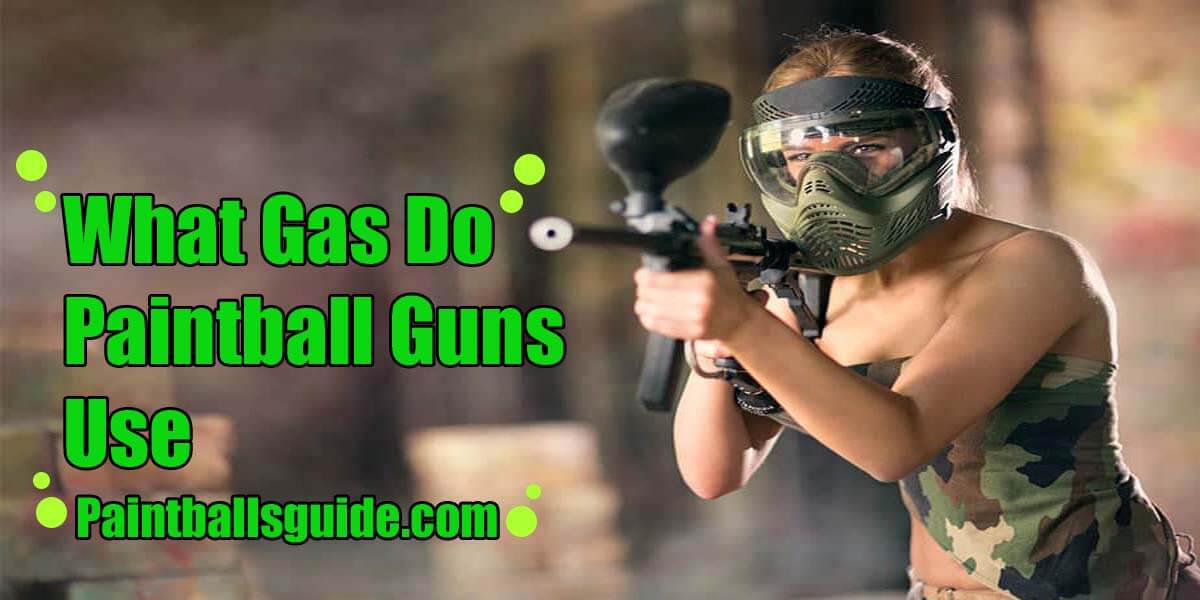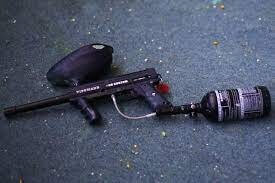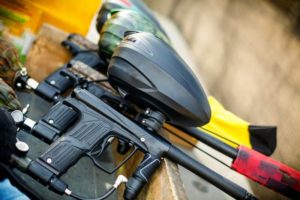High-pressure air (HPA) and carbon dioxide are the two primary compressed gas sources used in paintball tanks (Co2). The type of gas you require will depend on several variables, the two most crucial of which are the location of your game and the type of gun (referred to as a marker) you’ll be using.
Compressed air is used by most modern mechanical or electronic markers, while the older or less expensive mechanical markers can frequently operate on either co2 or HPA.
The paintball gas tank that came with your paintball gun will eventually need to be replaced or refilled. Which type of gas tank will you require, then?
The most OK paintball gas tank for you will depend on various factors, so let’s get started.
Table Of Contents
What Gas Do Paintball Guns Use?
A paintball marker uses one of two different types of gas as fuel, as CO2 and HPA, often known as compressed air, are both gases. Each has a unique set of benefits because CO2 is more widely available and quickly refills the tank.
Due to the lower pressure on the CO2, the tanks are less expensive. Since CO2 has a higher energy density, a tank of CO2 can hold more shots.
It’s challenging to locate HPA with a 3000+ psi pressure, and it costs 5x to 10x as much in HPA tanks. This equipment is typically only found in firehouses, dive shops, hydro testing labs, and paintball fields.
Similar to scuba diving, firefighters utilize 3700psi HPA tanks for breathing. You’ll need your adapters because it’s likely that these shops won’t have any available for filling HPA tanks. Prepare to fill these tanks before each next game you play.
How Compressed Air (HPA) and CO2 Work, Pros & Cons
Compressed Air (HPA) and CO2 are used the most frequently today and are the two primary air sources in paintball. They are entirely different gases, and not all paintball guns work with both air sources. Simply put, both exert pressure on a paintball marker so that it cycles and shoots the paintball. However, each operates according to a different theory, and occasionally only one can be applied.
Compressed Air (Hpa) Tanks
As rapid-fire markers proliferated in the 1990s, HPA tanks increased in popularity. These versions, sometimes referred to as Nitro, N2, or Nitrogen tanks, come in various sizes, commonly ranging from 3000 PSI to 4500 PSI (More shots are conceivable the higher the pressure).
The key benefit of compressed air is that it will function more reliably than CO2, mainly when shooting at fast speeds. It is a far better option for outdoor paintballing in cold weather because it won’t be as affected by environmental factors such as temperature and CO2. The initial cost of compressed air can be significantly higher than that of CO2, which is a drawback.
Pros Of HPA Tank
⦁ Cold weather and rapid-fire rarely make a difference under constant pressure.
⦁ On the field, between games can be filled.
⦁ There is less chance of a liquid leak into the marker, which is better for the seals and other components.
⦁ Most premium or electro-pneumatic indicators demand it.
⦁ A pressure gauge can determine how much air is still within.
Cons Of HPA Tank
⦁ Over and above CO2 expenditures, upfront costs are higher.
Carbon Dioxide (CO2)
The initial paintball markers used carbon dioxide, which set the bar early on for the business. The process by which a CO2 tank operates is to turn liquid CO2 that has been stored into gas form. The CO2 expands as it does so, creating pressure that pushes the paintball into the barrel.
Although CO2 tanks are often less expensive than HPA tanks, they have some drawbacks. The tank needs to be warm—around 75°F—for the liquid CO2 to turn into gas. Inconsistent performance results from playing in cold weather since the gas won’t expand properly, lowering tank pressure. High firing rates are problematic for CO2 as well because the tank gets colder and loses PSI the faster it changes from liquid to gas.
Pros Of CO2 Tank
⦁ Refills cost not too much.
⦁ Usually, tanks produce more shots than a comparable-sized compressed air tank.
⦁ It is much simpler to locate a CO2 provider to fill your tank than an HPA supply.
⦁ Low price (initial and ongoing)
⦁ Works nicely with entry-level markers and is appropriate for beginners.
Cons Of CO2 Tank
⦁ Especially in cold temperatures, it can perform inconsistently and have issues firing at high rates.
Which Paintball Gas Is Preferable, CO2 or HPA?
Both are effective for paintball, but HPA is preferable for those seeking greater effectiveness and accuracy. Co2 was used to create the first paintball markers, setting the standard for sources that were used in later years.
Pressure is produced when carbon dioxide expands from its liquid to a gas and is used to discharge the paintball through the barrel. Because the tanks are small and the refills for co2 are cheap, they can produce more shoots than compressed air. There are some problems, though. The more quickly the liquid expands, the faster it cools as it does so.
FAQs
Can Compressed Air Be Used To Fill A CO2 Tank?
Theoretically, you could, but in actuality, it’s not advised, as compared to compressed air tanks, CO2 tanks have substantially lower pressure ratings. You won’t even have enough fuel for 1 hopper if you fill a CO2 tank with HPA to the CO2 tank’s maximum pressure of 850 psi.
If you try to fill a C02 tank to the same pressures that HPA tanks are filled to—3000 psi or 4500 psi—you’ll probably have a significant accident with shrapnel hurtling through the air at high speed. Never even attempted this.
Also Read About: What Are The Different Types Of Paintball Guns
Can Paintball Tnks Be Refilled?
Yes, paintball tanks are refilled, as it doesn’t matter if the tank is a CO2 or HPA tank; you may always fill it up. Since the PSI of a nitrogen tank is higher than that of a CO2 tank, you might need to visit special filling stations.
Can I Fill My Tank On My Own Without Help?
No matter what kind of system they are part of, all air tanks must be shipped empty (except 12-gram cartridges, which must be transported by land). Only a trained operator is capable of filling CO2 tanks. Incorrect handling could harm the larger liquid CO2 tanks used to replace your tank.
Additionally, it would help if you emptied your CO2 tank before refilling it. To determine how much a CO2 tank has been filled, your CO2 tanks will weigh before and after.
Ensure the filling station you pick is appropriate for your tank rating before refilling an air compressor tank at the paintball field (3000 or 4500 psi). Ask at the field if you’re unclear about what to do; therefore, someone will always assist.
Are Other Gases Safe To Use With Nitrogen?
It costs a lot to buy nitrogen. As a result, when filling your tank with nitrogen, you can also use other gases that can be safely combined. But to save money, most HPA tanks today include other gases with nitrogen.
But to save money, most HPA tanks today include other gases with nitrogen.
How To Fill A Nitrogen Or Hpa Tank?
I advise you to go to a filling station for refills. These gases must be compressed under high pressure (between 3000 and 4500 PSI) in the tank, which can be risky for a novice. Additionally, it needs some sophisticated tools. Until you have the opportunity to visit a station, you can utilize CO2 if you urgently need a refill.
Conclusion’s:
It all depends on your playing style and marker, but if you can afford it, we strongly advise purchasing an HPA. The ideal alternative for players searching for the competitive edge is HPA or Nitrogen paintball gun tanks, as we covered in this article. Compared to CO2 tanks, these tanks are lighter, more stable, and more effective.
This is an excellent investment if paintball is something you take seriously. It’s best to add protection wherever you can because paintball tanks may be expensive. Use the selection of grips and covers to shield your tank from dents, bumps, and scratches.



Leave a Reply